duet
-
Brahms ― Sonata, Op.120 No.1 ― Alto Flute
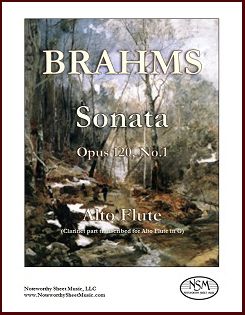 Sonata, Op.120 No.1, by Johannes Brahms
Sonata, Op.120 No.1, by Johannes BrahmsTranscribed for Alto Flute by J.W.Pratt
Alto Flute Part, PDF $8.99
Although written originally for clarinet, Brahms himself created two more versions of his Op.120 sonatas, for violin and viola. John W. Pratt, who transcribed these works for alto flute so expertly, writes in his foreword: "If Brahms was happy with versions for clarinet, viola, and violin, surely he would have welcomed arrangements for alto flute, especially since it is the mellow rather than the clarion aspect of the clarinet that he called on. In making our arrangements for alto flute, the violin versions have been particularly helpful, since the violin has the same lower range as the alto flute, but they required modification for several reasons. One, of course, is that the alto flute cannot play as loudly at the bottom of its range as the violin can. Another is that Brahms gave the violin double stops even though the clarinet is limited to a single voice." Our editions of the two Op.120 sonatas include only the alto flute parts, as Brahms' piano scores are freely available in the public domain. Here is a link to the listing of Op.120 No.1 on IMSLP.org, where the clarinet, viola, and violin versions with piano scores may be found. Our alto flute arrangements are based on the usual piano parts that accompany the clarinet as the solo instrument. The entire transcription of Op.120 No.1 works remarkably well, but the breathtakingly beautiful slow movement played on alto flute will steal your heart away.
Alto Flute part, 9 pages; Total 14 pages.
Preview -
Brahms ― Sonata, Op.120 No.2 ― Alto Flute
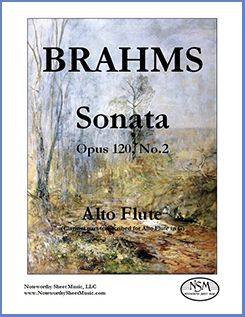 Sonata, Op.120 No.2, by Johannes Brahms
Sonata, Op.120 No.2, by Johannes BrahmsTranscribed for Alto Flute by J.W.Pratt
Alto Flute Part, PDF $8.99
This is the second of Brahms' two clarinet sonatas, transcribed for alto flute by John Pratt. Although written originally for clarinet, Brahms himself created two more versions of his Op.120 sonatas, for violin and viola. Mr. Pratt, who transcribed these works for alto flute so expertly, writes in his foreword: "If Brahms was happy with versions for clarinet, viola, and violin, surely he would have welcomed arrangements for alto flute, especially since it is the mellow rather than the clarion aspect of the clarinet that he called on. In making our arrangements for alto flute, the violin versions have been particularly helpful, since the violin has the same lower range as the alto flute, but they required modification for several reasons. One, of course, is that the alto flute cannot play as loudly at the bottom of its range as the violin can. Another is that Brahms gave the violin double stops even though the clarinet is limited to a single voice." Our editions of the two Op.120 sonatas include only the alto flute parts, as Brahms' piano scores are freely available in the public domain. Here is a link to the listing of Op.120 No.2 on IMSLP.org, where the clarinet, viola, and violin versions with piano scores may be found. Our alto flute arrangements are based on the usual piano parts that accompany the clarinet as the solo instrument.
Alto Flute part, 8 pages; Total, 12 pages.
Preview -
Briccialdi - Fantaisie pour la Flûte - Fl & Pf
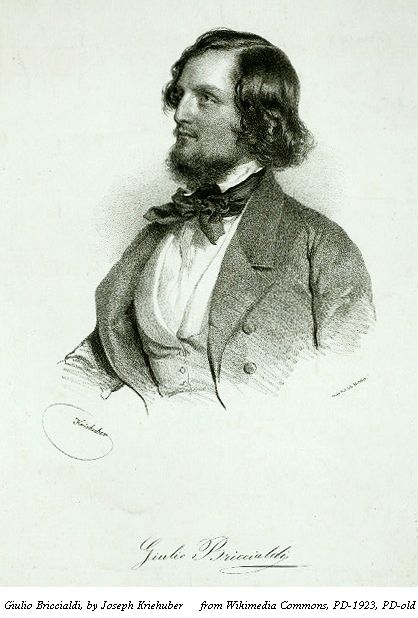 Fantaisie pour la Flûte, Op.110, by Briccialdi
Fantaisie pour la Flûte, Op.110, by BriccialdiGassett Collection - Facsimile Edition by C.A.Vater/Noteworthy Sheet Music
Flute Part and Piano Score, PDF $13.50
The virtuoso Italian flutist Giulio Briccialdi (1818-1881) was a captivating performer and a brilliant and prolific composer of works for the flute. His compositions became highly popular among flutists and include several concerti and numerous duets, caprices, fantasies, and etudes. He served as professor of flute at the Academy of St. Cecilia in Rome and later at the Florence Conservatoire. A proponent of the Boehm flute, Briccialdi is best known today for his invention of the Briccialdi B-flat thumb key and for his variation on the Carnival of Venice, "Il Carnevale di Venezia" (Op.78). We offer here our facsimile edition of his charming, challenging, and otherwise unavailable Fantaisie pour la Flûte sur des motifs de l'opera La Sonnambula de Bellini (Op.110).
For additional information about the Gassett Collection, please see see our article An Introduction to the Gassett Collection.
Piano score, 13 pages; Flute part, 5 pages; Total 23 pages.
Preview -
Bridge – 4 More Short Pieces – Flute or Alto Flute (and Piano)
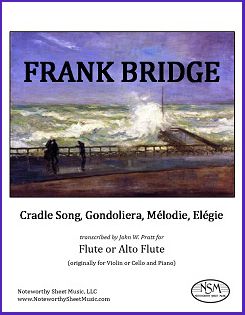 Cradle Song, Gondoliera, Mélodie, and Elégie, by Frank Bridge
Cradle Song, Gondoliera, Mélodie, and Elégie, by Frank BridgeTranscribed for Flute or Alto Flute (and Piano) by J. W. Pratt
Preview
Flute Part, Alto Part, PDF $11.99
Like the 4 Short Pieces for Violin and Pianoforte published in transcription by Noteworthy Sheet Music earlier this year, these additional four short pieces by Bridge "provide a fine and delightful introduction to an accessible post-romantic composer who should be better known." Published by Bridge between 1903 and 1911, the works included in our second edition are transcriptions of Cradle Song, written for violin or cello and piano, Gondoliera for violin and piano, and Mélodie and Elégie for cello and piano. Mr. Pratt has created transcriptions of all four pieces for both flute and alto flute, and we include both instrument versions in this combined edition. We think Cradle Song and Elégie are particularly beautiful on the alto flute, but all are effective on either instrument, so we prefer to let our flutists decide on which instrument they choose to play each piece. We provide our flute and alto flute parts only; the original piano scores work well with our transcriptions and are available, along with the violin and cello parts, as free pdf downloads at imslp.org—click the links to access the scores for Cradle Song, Gondoliera, Mélodie, and Elégie.
Flute part, 6 pages; Alto Flute part, 6 pages; Total, 14 pages. -
Bridge – 4 Short Pieces – Flute or Alto Flute (and Piano)
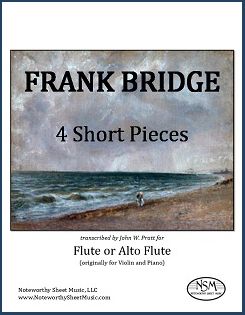 4 Short Pieces, by Frank Bridge
4 Short Pieces, by Frank BridgeTranscribed for Flute or Alto Flute (and Piano) by J.W.Pratt
Flute Part, Alto Part, PDF $8.99
The 4 Short Pieces by Frank Bridge were written for violin and piano, and first published in 1912. As noted in John Pratt's foreword to the edition, they "provide a fine and delightful introduction to an accessible post-romantic composer who should be better known." The pieces are "Meditation", "Spring Song", "Lullaby", and "Country Dance". Mr. Pratt has created transcriptions of the violin parts for both flute and alto flute, and we include both instrument versions in this edition. We think Nos. 1 and 3 sound particularly nice on the alto flute and No. 4 is a splendid romp on the C flute, but all four are effective on either instrument, so we prefer to let our flutists decide on which instrument they choose to play each piece. We provide only our flute and alto flute transcriptions; the piano score, including the original violin part, is available as a free pdf download at imslp.org.Flute part, 5 pages; Alto Flute part, 5 pages; Total, 14 pages.
Preview
-
Bridge – Two Pieces: Pensiero and Allegro appassionato – trans. for Clarinet and Piano
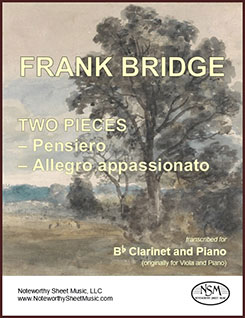 Two Pieces: Pensiero and Allegro appassionato, by Frank Bridge
Two Pieces: Pensiero and Allegro appassionato, by Frank BridgeTranscribed for B-flat Clarinet and Piano by C.A.Vater
Score and Part; PDF $10.99
Certain chamber works written for viola can also work very beautifully when transcribed for clarinet, and indeed may actually be coveted by clarinetists. Brahms’ Two Songs for Voice, Viola and Piano, Op. 91 is one such piece, and our transcription has become one of NSM’s most popular publications. Clarinetists may discover that our adaptation of the viola part of Frank Bridge’s Two Pieces: Pensiero and Allegro appassionato, written for viola and piano, is also well-conceived and enjoyable to play. As suggested by their titles, these two pieces were written in very different styles, but they complement each other well, showing off Bridge’s composing versatility and providing performers an opportunity to display a range of emotions and capabilities. In our edition, we have raised the Pensiero key from F minor to G minor, taken a few passages in both pieces 8va to bring them into clarinet range, and created clarinet-friendly adaptations for the viola’s occasional double stops, but otherwise the pieces remain as Bridge composed them.
Score, 10 pages; Clarinet part, 3 pages; Total, 16 pages.
Preview
-
Burleigh - Southland Sketches, Nos. I, III, IV - Alto Flute or Flute (& piano)
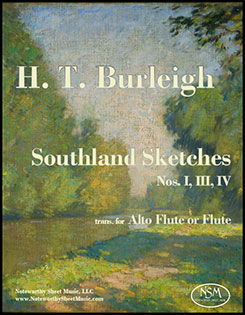 Southland Sketches, Nos. I, III, IV, by H. T. Burleigh
Southland Sketches, Nos. I, III, IV, by H. T. BurleighTranscribed for Alto Flute or Flute (and piano) by C. A. Vater
Alto Flute part and Flute part, PDF $9.96
Harry Thacker Burleigh was an acclaimed African-American singer, music editor, and composer whose adaptations of African-American spirituals became famous. His Southland Sketches, which were composed for violin and piano and published by G. Ricordi in 1916, are a fine example of Burleigh’s quintessential American style. The original composition included 4 movements. Our edition excludes the second movement, but adapts three of the original four miniatures for either alto flute or flute. We provide only the transcribed alto flute and flute parts, as they have been designed to work well with the piano part in the original score for violin and piano which is available as a good quality, free pdf download from imslp.org. Performers may choose to play all three of these pieces on either flute or alto flute, or switch instruments between sketches, depending on personal preference.
Alto Flute part, 6 pages; alternate Flute part, 6 pages; Total,18 pages. (pdf of piano accompaniment is freely available at imslp.org)
Preview
-
Cambini - Sonata in D Major - Flute and Clarinet
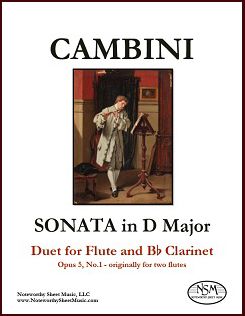 Sonata in D Major, Op.5, No.1, by Giuseppe Maria Cambini
Sonata in D Major, Op.5, No.1, by Giuseppe Maria CambiniTranscribed for Flute and B-flat Clarinet by R.A.Evans
Score and Parts, PDF $7.99Giuseppe Maria Cambini (1746-1825) was an Italian-born violinist and composer. He was one of the most prolific composers of his era, particularly of instrumental works, of which he wrote over 600, including numerous symphonies, 149 string quartets and over 100 trios, as well as ballets, operas, & oratorios. Flutists will know him for his concertos and extensive body of chamber works featuring the flute, including duos, trios, quartets and quintets.
Cambini wrote his Sonata in D Major, Op.5, No.1 for two flutes, and Noteworthy Sheet Music has published a re-notated version of the flute duet at the suggestion of flutist Richard A. Evans, who long ago obtained the music from the Library of Congress and believed it undeserving of its current obscurity. Aware of the scarcity of music composed for flute-clarinet duos, Mr. Evans also initiated this flute-clarinet edition of Cambini's Sonata in D Major by transcribing the flute-2 part for clarinet in B-flat. We at NSM agreed that the Op.5, No.1 duet should be made more readily available to present-day musicians and audiences, in both the flute-flute and flute-clarinet versions. Our editions provide both scores and parts, and incorporate articulation and dynamic edits supplied by Mr. Evans.Score, 8 pages; Flute part, 4 pages; B-flat Clarinet part 4 pages; Total, 22 pages.
Preview -
Cambini - Sonata in D Major - Two Flutes
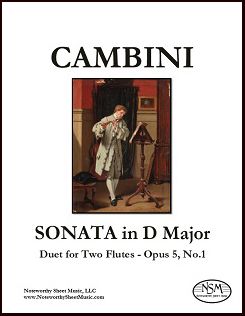 Sonata in D Major, Op.5, No.1, by Giuseppe Maria Cambini
Sonata in D Major, Op.5, No.1, by Giuseppe Maria CambiniDuet for Two Flutes
Score and Parts, PDF $7.99Giuseppe Maria Cambini (1746-1825) was an Italian-born violinist and composer. He was one of the most prolific composers of his era, particularly of instrumental works, of which he wrote over 600, including numerous symphonies, 149 string quartets and over 100 trios, as well as ballets, operas, & oratorios. Flutists will know him for his concertos and extensive body of chamber works featuring the flute, including duos, trios, quartets and quintets.
Noteworthy Sheet Music published this edition of Cambini's Sonata in D Major, Op.5, No.1 at the suggestion of flutist Richard A. Evans, who long ago obtained the duet from the Library of Congress and believed it undeserving of its current obscurity. We at NSM agreed that the duet should be made more readily available to present-day musicians and audiences. Our edition provides both score and parts, and incorporates articulation and dynamic edits supplied by Mr. Evans.
Note that Cambini's Opus 5 flute duets were made into trios by the addition of a bass part composed by Thomas Billington. A PDF scan of the trio edition for two flutes and continuo arranged by Billington is available at IMSLP.org as Cambini's 6 Duos for Two Flutes, Opus 11 (London, printed for Longman & Broderip, n.d.).
Score, 8 pages; Flute-1 part, 4 pages; Flute-2 part 4 pages; Total, 22 pages.
Preview -
CD - Tea-Time Classics - Flute and Harp
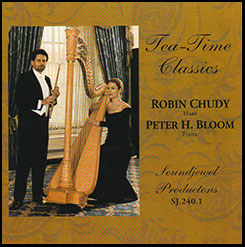 Tea-Time Classics
Tea-Time Classics
Robin Chudy, harp and Peter H. Bloom, flute
Soundjewel Productions, SJ.240.1, CD $14.97
This sachet of classic and exotic harp and flute music was inspired by the elegant ritual of afternoon tea. It is the ideal accompaniment to tea-time, or any time an infusion of relaxation and euphoria is needed. Previously based in Boston, harpist Robin Chudy played the harp daily for fourteen years at the Ritz-Carlton Hotel, where she developed a style suited to relaxed listening in the Tea Lounge and Cafe, and acquired a broad repertoire of classical and lighter compositions, many her own arrangements. Well-known to our website visitors, Peter H. Bloom is a consummate flutist, NSM editorial consultant, and NSM contributing composer and arranger.Tea-Time Classics
To listen to audio clips of selected tracks, click on the mp3 icons beside the titles.
1. Menuet from l’Arlésienne Suite no. 2, Georges Bizet, 4:12

2. Morceau de Concours, Gabriel Fauré, 2:29
3. Suite of Waltzes from Tales from the Vienna Woods, Johann Strauss, 8:06
5. First Arabesque, Claude Debussy, 4:13
6. Entr’acte from Act III of the opera Carmen (arr: Quinto Maganini), Georges Bizet, 4:17
7. Romanza from Act I of the opera La Wally, Alfredo Catalani, 3:18
8. Sentimental Walk from Diva (Tr: Ed Meredith, arr: R. Chudy), Vladimir Cosma, 3:07
9. Danza Habanera, Th. H. Northrup, 3:04
10. I Dreamt I Dwelt in Marble Halls from The Bohemian Girl, M. W. Balfe, 4:27
11. Theme from Brideshead Revisited, Geoffrey Burgon, 2:44
12. Gnossienne no. 1, Erik Satie, 2:23
13. Gnossienne no. 2, Erik Satie, 1:25
14. Gnossienne no. 3, Erik Satie, 1:59
15. Rêverie, Claude Debussy, 3:30
16. Étude, Opus 10 no. 3 (excerpt), F. Chopin, 2:28
17. The Swan, Camille Saint-Saëns, 2:20To order a copy of theTea-Time Classics CD for $14.97, please use the Noteworthy Sheet Music Contact Us form to let us know which CD(s) you would like to purchase, along with your email contact information and shipping address. For orders shipping to addresses in the USA, a $4.99 shipping and handling fee will be added; for international orders shipping outside the USA, the fee is $14.99. We will send you a PayPal invoice for the sale and, once we receive notice from PayPal that you have paid for the item(s), Americas Musicworks will ship your CD(s) to the address provided, for delivery in 7-10 days.
-
Coste - Cavatine - Afl + Pf
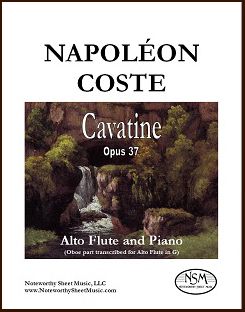 Cavatine, Op.37, by Napoléon Coste
Cavatine, Op.37, by Napoléon CosteTranscribed for Alto Flute and Piano by C.A.Vater
Piano Score and Alto Flute Part, PDF $8.25
Napoléon Coste (1805-1883) was born in a small village in the Départment of the Doubs, France. He began to play guitar at the age of 6, studying with his mother who was an accomplished guitar performer. Napoléon himself began teaching and performing on guitar as a teenager. At age 24 he moved to Paris, where he studied under Fernando Sor, the renowned Spanish classical guitarist and composer. Coste quickly established himself as a virtuoso and is widely acknowledged as the dominant French guitarist of his era.
Coste became famous not only as a guitar soloist, but also as a major composer of some 60 works, most of which were written for guitar. His Op.37 "Cavatine" is a short, single-movement piece for piano and oboe (or violin or flute). Melodic but lively in places, the work should appeal to amateurs of a moderate or higher skill level. Our transposition of Cavatine falls nicely within the range of the alto flute and sounds appealing and completely natural on that instrument. The Noteworthy Sheet Music edition includes a score for piano and alto flute, in addition to the transcribed alto flute part.
Alto Flute part, 3 pages; Piano Score, 8 pages; Total, 16 pages.
Preview -
Coste - Les Regrets - Afl or Fl (or Ob, Vn) and Pf (or Guitar, Harp)
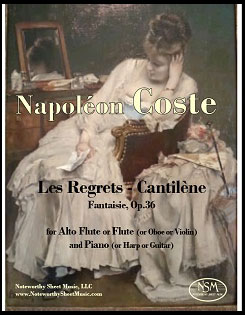 Les Regrets-Cantilène, Op.36, by Napoléon Coste
Les Regrets-Cantilène, Op.36, by Napoléon CosteTranscribed for Alto Flute or Flute (or Oboe or Violin) and Piano (or Harp or Guitar) by C.A.Vater
Score, Alto Flute Part, and alternative Flute (or Oboe or Violin) Part, PDF $5.99
Napoléon Coste (1805-1883) became famous not only as a guitar soloist, but also as a major composer of some 60 works, most of which were written for guitar. His music is in the romantic French style and appreciated for its originality. His Fantaisie, Op.36, Les Regrets-Cantilène, is a short, single-movement piece written for oboe or violin with piano or harp or guitar. We created our Noteworthy Sheet Music edition from the difficult-to-read manuscript version in the public domain, available on imslp.org. We include a score in concert pitch and a part suitable for flute, oboe or violin, as well as a part transcribed for alto flute in G. The piece falls nicely within the sweet range of the alto flute and our transposition sounds appealing and completely natural on that instrument. In fact, Les Regrets-Cantilène is gorgeous on either flute or alto flute. Melodic and sentimental, the work is not overly demanding technically and should appeal to players of a moderate or higher skill level.
Preview
Score, 4 pages; Alto Flute part, 1 page; Flute (or Oboe or Violin) part, 1 page; Total 8 pages. -
Danzi - Grande Sonate - Piano & Basset Horn
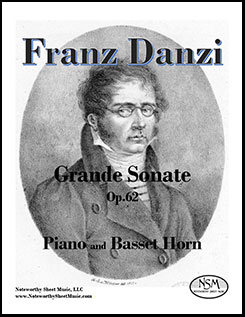 Grande Sonate, Op.62, by Franz Danzi
Grande Sonate, Op.62, by Franz Danzifor Piano and Basset Horn; re-notated, edited, and with occasional ossia elaborations suggested by John W. Pratt
Piano Score and Basset Horn Part, PDF $13.99
Franz Danzi (1763-1826) was an active musician, cellist, and teacher in Mannheim, Munich, Stuttgart, and Karlsruhe. A prolific composer, especially of music for the stage and chamber music from keyboard solos to sextets, he revered Mozart and mentored Weber. His wind quintets are notable. His Grande Sonate, Opus 62, for piano and basset horn, was published about 1823, along with an alternative cello part which sometimes differs from the basset horn part in other ways than octave transposition. // The original publication of Danzi’s Opus 62 is available at imslp.org., but there is no full score and the parts are hard to play from, or sometimes even to read at all, lack measure numbers, have a few errors, and differ in the number of measures in the last two movements. We have therefore prepared a full score including the basset horn in concert pitch, to facilitate checking the fit of the basset horn and piano lines and our transcriptions for other instruments against the original. — excerpted from John Pratt’s foreword to the edition
Piano Score, 28 pages; Basset Horn part, 7 pages; Total 40 pages.
Preview -
Danzi - Grande Sonate - Piano & Flute
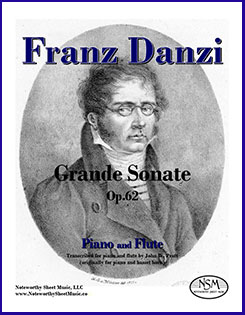 Grande Sonate, Op.62, by Franz Danzi
Grande Sonate, Op.62, by Franz Danzitranscribed for Piano and Flute by John W. Pratt
Piano score and Flute part, PDF $14.99
excerpted from John Pratt’s foreword to the edition: 'Franz Danzi (1763-1826) was an active musician, cellist, and teacher in Mannheim, Munich, Stuttgart, and Karlsruhe. A prolific composer, especially of music for the stage and chamber music from keyboard solos to sextets, he revered Mozart and mentored Weber. His wind quintets are notable. His Grande Sonate, Opus 62, for piano and basset horn, was published about 1823, along with an alternative cello part which sometimes differs from the basset horn part in other ways than octave transposition. // The sound of the basset horn varies widely, depending on its construction, who is playing, what is being played, and who is describing it. George Bernard Shaw said, ''The devil himself could not make a basset horn sparkle.'' Burnet Tuthill, in Cobbett's Cyclopedic Survey of Chamber Music (1929), wrote of its "soft mellow timbre of rich beauty.” E.T.A. Hoffmann likened its sound to the scent of red carnations (see Georgina Dobré, The Basset Horn,who says, pace Shaw, “Sparkle it certainly can!”). That tent is broad enough to cover the characteristics of both the flute and the clarinet comfortably, and Danzi’s Grande Sonate alternates sparkle and mellow rich beauty in large measure.' Since we at NSM have grown quite fond of this piece, we decided to transcribe it for both flute and clarinet, so we and our friends could enjoy playing it. We offer here the flute edition, with a version for clarinet to follow in the coming weeks.
Piano score, 28 pages; Flute part, 7 pages; Total 40 pages.
Preview -
Danzi - Grande Sonate - Piano and Clarinet
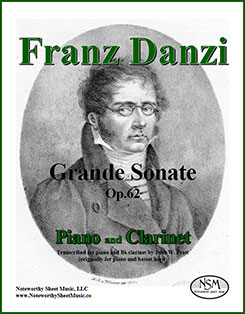 Grande Sonate, by Franz Danzi
Grande Sonate, by Franz Danzitranscribed for Piano and Clarinet by John W. Pratt
Piano score and B♭ Clarinet part, PDF $14.99
Danzi’s Grande Sonate, Opus 62, written for piano and basset horn, was published around 1823, along with an alternative part for cello. Please see additional information about this piece in the article describing our re-notated basset horn edition. The Grande Sonate comprises four movements and provides both sparkle and mellow rich beauty. It is nicely adaptable to other winds, particularly the clarinet. Certain passages in the final movement of the original work seem to invite elaboration or improvisation by the solo instrument, and arranger John Pratt offers suggestions for possible additions or alternatives for the clarinet, making it even more fun to play.
Piano Score, 28 pages; B♭ Clarinet Part, 7 pages; Total, 40 pages.
Preview -
Debussy - Première Rhapsodie - Alto Flute
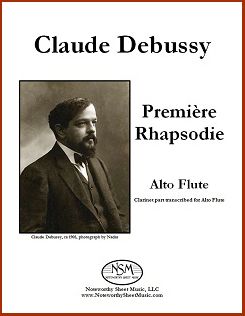 Première Rhapsodie, by Claude Debussy
Première Rhapsodie, by Claude DebussyTranscribed for Alto Flute by C.A.Vater, with a Foreword by P.H.Bloom
Alto Flute Part ― PDF $5.99
Since its introduction as a morceau de concours for the Paris Conservatoire in 1910, Debussy's Première Rhapsodie has been an essential piece of the clarinet repertoire.... Although most of the morceaux are, by definition, run-of-the mill exercises of virtuosity à la mode, a number have endured as works of significant musical merit. Debussy's Première Rhapsodie is one such piece. It's a vehicle for expressive interpretation and artistry, with charm, warmth, passion, and humor; a lasting treasure at the core of every clarinetist's collection of indispensable works.... But a transcription? Of a work by Debussy - the great colorist of instrumental sonority? From clarinet to alto-flute?... Each and every element, in fact, evokes the alto-flute!... Of course the piece sounds different on the two instruments. Although the sonic hues are different, the colors are just as vivid. The distinct sonorities of the alto-flute support the nuance, the affect, and the power of the work. (excerpted from Peter H. Bloom © 2012)
We provide our alto flute part only; appropriate parts for piano or orchestral accompaniment may be obtained as free pdf downloads from public domain resources, such as imslp.org.
Alto Flute part, 4 pages.
Preview -
Devienne - Sonata in D Major - Flute and Clarinet
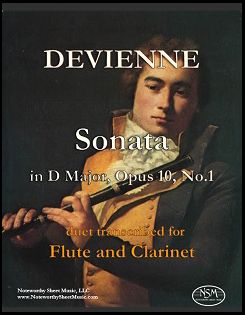 Sonata in D Major, Op.10, No.1, by François Devienne
Sonata in D Major, Op.10, No.1, by François DevienneDuet transcribed for Flute and Clarinet
Score and Parts, PDF $9.99François Devienne (1759-1803) was a French composer, flutist and bassoonist, as well as a professor at the Paris Conservatory. His compositional output included: 12 operas; many concerted pieces for various wind instruments, with orchestra; overtures; concertos, quartets, trios, sonatas, etc. for flute, piano, and other instruments; 12 suites; numerous romances, chansons, etc.; and an influential flute method book, Méthode de flûte (1795).
Noteworthy Sheet Music published this edition of Devienne's Sonata in D Major, Op.10, No.1 at the suggestion of flutist Richard A. Evans, who long ago obtained the original flute-flute duet from the Library of Congress and believed it undeserving of its current obscurity. Aware of the paucity of repertoire available for flute and clarinet, and realizing the piece would work nicely for that instrument pair as well, he transcribed the second flute part for B♭ clarinet. We at NSM agreed that the duet, which has two movements, Allegro spirituoso and Rondo: Allegro poco presto, should be made more readily available to present-day musicians and audiences. Our edition provides both score and parts and incorporates articulation and dynamic edits supplied by Mr. Evans.Score, 10 pages; Flute part, 5 pages; B♭ clarinet part, 5 pages; Total, 24 pages.
-
Devienne - Sonata in D Major - Two Flutes
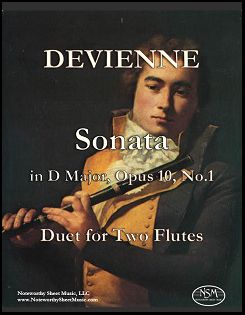 Sonata in D Major, Op.10, No.1, by François Devienne
Sonata in D Major, Op.10, No.1, by François DevienneDuet for Two Flutes
Score and Parts, PDF $9.99
François Devienne (1759-1803) was a French composer, flutist and bassoonist, as well as a professor at the Paris Conservatory. His compositional output included: 12 operas; many concerted pieces for various wind instruments, with orchestra; overtures; concertos, quartets, trios, sonatas, etc. for flute, piano, and other instruments; 12 suites; numerous romances, chansons, etc.; and an influential flute method book, Méthode de flûte (1795).
Noteworthy Sheet Music published this edition of Devienne’s Sonata in D Major, Op.10, No.1 at the suggestion of flutist Richard A. Evans, who long ago obtained the duet from the Library of Congress and believed it undeserving of its current obscurity. We at NSM agreed that the duet, which has two movements, Allegro spirituoso and Rondo: Allegro poco presto, should be made more readily available to present-day musicians and audiences. Our edition provides both score and parts, and incorporates articulation and dynamic edits supplied by Mr. Evans.
Score, 10 pages; Flute-1 part, 5 pages; Flute-2 part 5 pages; Total, 24 pages.
Preview -
Dieter - The Golden “Reade” Flute - Flute & Piano
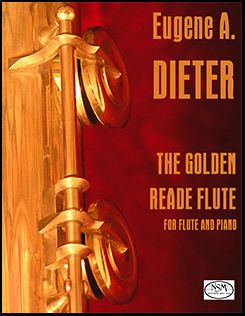 The Golden "Reade" Flute, by Eugene A. Dieter
The Golden "Reade" Flute, by Eugene A. DieterFlute Part and Piano Score ― PDF $7.99
Elmer Reade (1898-1986), to whom The Golden "Reade" Flute is dedicated, served a long and distinguished career, first as a flutist with the U.S. Army Band and then as a conductor and music director of the Air Force Band at Mitchell Field, New York. Eugene A. Dieter graduated from the first class of the US Army Music School in 1941 and was appointed a bandmaster. Following the Second World War, Dieter accepted a bandmaster position with the Air Force Band and remained active until his retirement in 1966. Likely, it was as an Air Force band colleague of Elmer Reade's that Dieter was inspired to compose The Golden "Reade" Flute. (excerpted from the foreword © by P. H. Bloom)
Not at all militaristic in character, The Golden "Reade" Flute is more a lovely barcarole, a single Andante moderato movement in 6/8 time. It offers interesting writing for both parts, so flutist and pianist will be equally pleased. The title refers to the gold flute by William S. Haynes upon which Reade regularly performed.
Piano score, 4 pages; Flute part, 2 pages.
Preview -
Dressler - Portrait Charmant - Flute (or Vn) & Piano
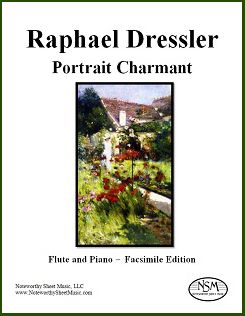 Portrait Charmant, by Raphael Dressler
Portrait Charmant, by Raphael DresslerGassett Collection - Facsimile Edition by C.A.Vater/Noteworthy Sheet Music
Part for Flute or Violin and Piano Score, PDF $3.00
Raphael Dressler (1784-1835) was a well-known Austrian flutist and composer. He wrote more than 100 compositions for flute and published a popular flute method book, New and Complete Instructions for the Flute. His career included a position as first flutist in the Kärntnerthor Theater orchestra in Vienna and many years as a teacher and performer in London. Dressler's Portrait Charmant is the fifth of his Douze Thèmes Favoris pour Pianoforte et Flûte (ou Violon). The piece is a short work, simple yet indeed charming, and playable by flutists (or violinists) and pianists of many skill levels. A favorite of ours, Portrait Charmant can also be played effectively as a solo work for flute or violin alone.
For additional information about the Gassett Collection, please see see our article An Introduction to the Gassett Collection.
Piano score, 3 pages; Flute or Violin part, 1 page; Total, 8 pages.
Preview